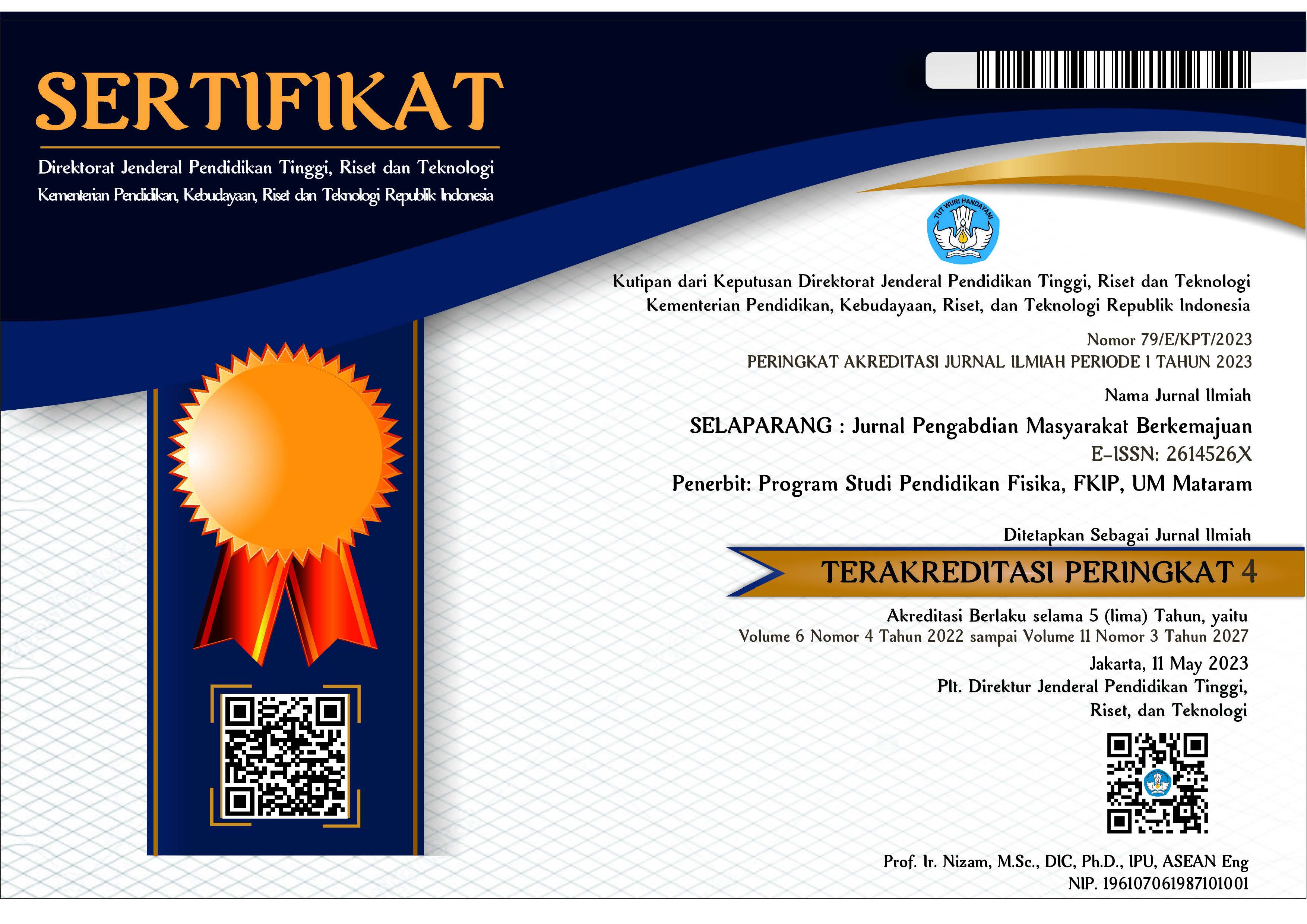Manajemen kesehatan tanaman hortikultura di desa Sukorambi kabupaten Jember
Abstract
Abstrak
Pengetahuan dan pemahaman yang kuat tentang pengendalian hama dan penyakit tanaman merupakan aspek penting dalam mendukung produktivitas dan keberlanjutan sektor pertanian. Studi ini mengevaluasi efektivitas program edukasi manajemen kesehatan tanaman hortikultura di Desa Sukorambi, Kabupaten Jember. Program ini bertujuan untuk meningkatkan pemahaman petani terkait praktik-praktik pengendalian yang lebih baik melalui partisipasi aktif petani dan mahasiswa dalam penyampaian materi. Metode yang digunakan terdiri atas penyampaian materi melalui metode visual dan diskusi, yang memungkinkan pemahaman oleh petani. Hasil evaluasi menunjukkan peningkatan pemahaman petani tentang manajemen kesehatan tanaman, yang tercermin dalam peningkatan skor pemahaman dan motivasi. Hasil dari analisis SWOT menunjukkan bahwa program ini memiliki kekuatan dalam keterlibatan aktif petani dan dukungan dari universitas. Namun, ada kelemahan yang perlu diatasi, terutama terkait dengan keterbatasan anggaran dan infrastruktur. Program ini juga menghadapi peluang seperti potensi dukungan tambahan dari pihak eksternal dan peluang untuk memperluas jaringan kerja sama dalam sektor pertanian. Ancaman yang harus diperhatikan adalah perubahan kebijakan pemerintah yang dapat memengaruhi pendanaan program, serta potensi penurunan minat petani seiring berjalannya waktu. Kesimpulannya, program ini memiliki dampak positif dalam meningkatkan pemahaman petani terkait pengendalian hama dan penyakit tanaman. Dengan upaya lebih lanjut dan dukungan tambahan, program ini memiliki potensi untuk terus berperan penting dalam mendukung pertanian berkelanjutan dan produktif di wilayah Desa Sukorambi, Kabupaten Jember.
Kata kunci: hama; motivasi; patogen; pemahaman; seminar
Abstract
A strong knowledge and understanding of pest and disease control in plants are essential aspects to support productivity and sustainability in the agricultural sector. This study evaluates the effectiveness of an educational program on horticultural plant health management in Sukorambi Village, Jember Regency. The program aims to enhance farmers' understanding of improved pest and disease control practices through active participation of farmers and students in delivering the materials. The methods employed include the presentation of materials through visual aids and discussions, facilitating comprehension by farmers. The evaluation results indicate an improvement in farmers' understanding of plant health management, reflected in increased comprehension scores and motivation. The SWOT analysis reveals that the program has strengths in active farmer engagement and university support. However, it also identifies weaknesses, primarily related to budget constraints and infrastructure limitations. The program presents opportunities, such as potential external support and opportunities for expanding collaboration networks within the agricultural sector. Threats to be monitored include potential changes in government policies affecting program funding and the risk of declining farmer interest over time. In conclusion, this program has had a positive impact on enhancing farmers' understanding of pest and disease control in plants. With further efforts and additional support, the program has the potential to continue playing a crucial role in promoting sustainable and productive agriculture in the Sukorambi Village, Jember Regency.
Keywords: pest; motivation; pathogen; understanding; seminar
Keywords
Full Text:
PDFReferences
Abouziena H., & Haggag W. (2016). Weed control in clean agriculture: a review. Planta Daninha. 34:377-392. https://doi.org/10.1590/S0100-83582016340200019.
Alengebawy A., Abdelkhalek S. T., Qureshi S. R., & Wang M.-Q. (2021). Heavy metals and pesticides toxicity in agricultural soil and plants: Ecological risks and human health implications. Toxics. 9(3):42. https://doi.org/10.3390%2Ftoxics9030042.
Bajwa A. A. (2014). Sustainable weed management in conservation agriculture. Crop Protection. 65:105-113. https://doi.org/10.1016/j.cropro.2014.07.014.
Barzman M., Bàrberi P., Birch A. N. E., Boonekamp P., Dachbrodt-Saaydeh S., Graf B., Hommel B., Jensen J. E., Kiss J., & Kudsk P. (2015). Eight principles of integrated pest management. Agronomy for Sustainable Development. 35:1199-1215. https://doi.org/10.1007/s13593-015-0327-9.
Benzaghta M. A., Elwalda A., Mousa M. M., Erkan I., & Rahman M. (2021). SWOT analysis applications: An integrative literature review. Journal of Global Business Insights. 6(1):55-73. https://www.doi.org/10.5038/2640-6489.6.1.1148.
Buana B. J. D., & Suwandari A. (2020). Optimalisasi usahatani sayur tumpangsari di Desa Sukorambi Kecamatan Sukorambi Kabupaten Jember. Journal of Social and Agricultural Economics. 13(2):125-144. https://doi.org/10.19184/jsep.v13i2.15124.
Dara S. K. (2019). The new integrated pest management paradigm for the modern age. Journal of Integrated Pest Management. 10(1):12. https://doi.org/10.1093/jipm/pmz010.
Hasanuzzaman M., Mohsin S. M., Bhuyan M. B., Bhuiyan T. F., Anee T. I., Masud A. A. C., & Nahar K. (2020). Phytotoxicity, environmental and health hazards of herbicides: Challenges and ways forward. Di dalam: Prasad M. N. V. (editor). Agrochemicals Detection, Treatment and Remediation. Elsevier. hlm 55-99. https://doi.org/10.1016/B978-0-08-103017-2.00003-9.
Hollaway G., Evans M., Wallwork H., Dyson C., & McKay A. (2013). Yield loss in cereals, caused by Fusarium culmorum and F. pseudograminearum, is related to fungal DNA in soil prior to planting, rainfall, and cereal type. Plant Disease. 97(7):977-982. https://doi.org/10.1094/pdis-09-12-0867-re.
Hussain F., & Abid M. (2011). Pest and diseases of chilli crop in Pakistan: A review. International Journal of Biology and Biotechnology. 8(2):325-332.
Le D., Audenaert K., & Haesaert G. (2021). Fusarium basal rot: profile of an increasingly important disease in Allium spp. Tropical Plant Pathology. 46:241-253. https://doi.org/10.1007/s40858-021-00421-9.
Liu T., Bruins R. J., & Heberling M. T. (2018). Factors influencing farmers’ adoption of best management practices: A review and synthesis. Sustainability. 10(2):432. https://doi.org/10.3390/su10020432.
Liu Y., & He F. (2019). Incorporating the disease triangle framework for testing the effect of soil‐borne pathogens on tree species diversity. Functional Ecology. 33(7):1211-1222. https://doi.org/10.1111/1365-2435.13345.
Luna J. M., & House G. J. 2020. Pest management in sustainable agricultural systems. Di dalam: Luna J. M., House G. J. (editor). Sustainable Agricultural Systems. CRC Press. hlm 157-173.
Ma L.-J., Geiser D. M., Proctor R. H., Rooney A. P., O'Donnell K., Trail F., Gardiner D. M., Manners J. M., & Kazan K. (2013). Fusarium pathogenomics. Annual Review of Microbiology. 67:399-416. https://doi.org/10.1146/annurev-micro-092412-155650.
Martinelli F., Scalenghe R., Davino S., Panno S., Scuderi G., Ruisi P., Villa P., Stroppiana D., Boschetti M., & Goulart L. R. (2015). Advanced methods of plant disease detection. A review. Agronomy for Sustainable Development. 35:1-25. https://doi.org/10.1007/s13593-014-0246-1.
Okungbowa F., & Shittu H. (2012). Fusarium wilts: An overview. Environmental Research Journal. 6(2):83-102.
Pradana A. P., Savitri D. A., Hariyati Y., Winarso S., Sudarko S., Sofia S., Djatmiko M. W., & Masnilah R. (2023). Hilirisasi teknologi tepat guna produksi cendawan entomopatogen dan Trichoderma di Desa Sukorambi-Jember. Selaparang: Jurnal Pengabdian Masyarakat Berkemajuan. 7(3):1859-1866. https://doi.org/10.31764/jpmb.v7i3.17055.
Schellhorn N. A., Parry H. R., Macfadyen S., Wang Y., & Zalucki M. P. (2015). Connecting scales: Achieving in‐field pest control from areawide and landscape ecology studies. Insect Science. 22(1):35-51. https://doi.org/10.1111/1744-7917.12161.
Sharma S., Upadhayaya S., & Tiwari S. (2022). Biology and integrated management of tobacco caterpillar, Spodoptera litura Fab.: A systematic review. Journal of Agriculture and Applied Biology. 3(1):28-39. https://doi.org/10.11594/jaab.03.01.04.
Sibanda B. K., Iyawa G. E., & Gamundani A. M. (2021). Systematic review of plant pest and disease identification strategies and techniques in mobile apps. Trends and Applications in Information Systems and Technologies. 2(9):491-502. https://doi.org/10.1007/978-3-030-72651-5_47.
Srivastava K., Sharma D., Anal A., & Sharma S. (2018). Integrated management of Spodoptera litura: a review. International Journal of Life-Sciences Scientific Research. 4(1):1536-1538. http://dx.doi.org/10.21276/ijlssr.2018.4.1.4.
Stenberg J. A. (2017). A conceptual framework for integrated pest management. Trends in Plant Science. 22(9):759-769. https://doi.org/10.1016/j.tplants.2017.06.010.
Tilahun B., & Hussen A. (2014). Assessment of pesticide use, practice and risk in Gedeo and Borena zones; Ethiopia. International Journal of Environment. 3(3):201-209. http://dx.doi.org/10.3126/ije.v3i3.11079.
Vuković S. M., Inđić D. V., & Gvozdenac S. M. (2014). Phytotoxic effects of fungicides, insecticides and nonpesticidal components on pepper depending on water quality. Pesticides and Phytomedicine. 29(2):145-153. http://dx.doi.org/10.2298/PIF1402145V.
Wossen T., Abdoulaye T., Alene A., Haile M. G., Feleke S., Olanrewaju A., & Manyong V. (2017). Impacts of extension access and cooperative membership on technology adoption and household welfare. Journal of Rural Studies. 54:223-233. https://doi.org/10.1016/j.jrurstud.2017.06.022.
Zhang C., Hu R., Shi G., Jin Y., Robson M. G., & Huang X. (2015). Overuse or underuse? An observation of pesticide use in China. Science of the Total Environment. 538:1-6. https://doi.org/10.1016/j.scitotenv.2015.08.031.
DOI: https://doi.org/10.31764/jpmb.v8i1.21214
Refbacks
- There are currently no refbacks.

This work is licensed under a Creative Commons Attribution-ShareAlike 4.0 International License.
______________________________________________________
Jurnal Selaparang
p-ISSN 2614-5251 || e-ISSN 2614-526X
EDITORIAL OFFICE:



















